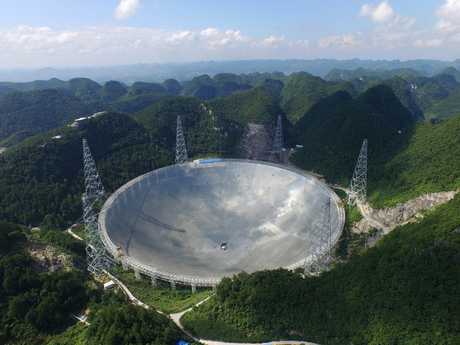World's largest radio telescope completed

The Chinese Academy of Sciences (CAS) has completed construction on the Five-hundred-meter Aperture Spherical Telescope (FAST) — the world’s largest radio telescope.
FAST was designed, developed and constructed entirely by Chinese scientists. Based in south-western China’s Guizhou Province, it boasts the world’s largest aperture, at 500 m, and has a total area equal to 30 soccer fields. It not only surpasses the Arecibo Observatory — once the world’s largest single-aperture telescope — in size, but also in sensitivity and overall performance.
Once put into operation, FAST will contribute to the observation of celestial bodies, making it possible to generate more reliable theories and models with which to verify modern physics and astronomy and offering large potential for new discoveries. It will enable scientists to survey neutral hydrogen in distant galaxies, detect faint pulsars, probe interstellar molecules and search for possible interstellar communication signals.
“FAST will lead the world for at least 10 to 20 years,” said Yan Jun, director general of the National Astronomical Observatories of China (NAOC) under CAS.

Although it is a Chinese facility, the telescope will be open to research proposals from the international scientific community. Nan Rendong, FAST’s general engineer and chief scientist, said the telescope’s Time Allocation Committee (TAC) will soon distribute observation time according to the scientific value of the proposals.
The telescope will now begin its debugging and testing stage.
Govt announces $158m in funding for three new CRCs
Minister for Industry and Science Ed Husic has allocated $158 million to three new Cooperative...
Why are young plants more vulnerable to disease?
Fighting disease at a young age often comes at a steep cost to plants' growth and future...
Liquid catalyst could transform chemical manufacturing
A major breakthrough in liquid catalysis is transforming how essential products are made, making...





